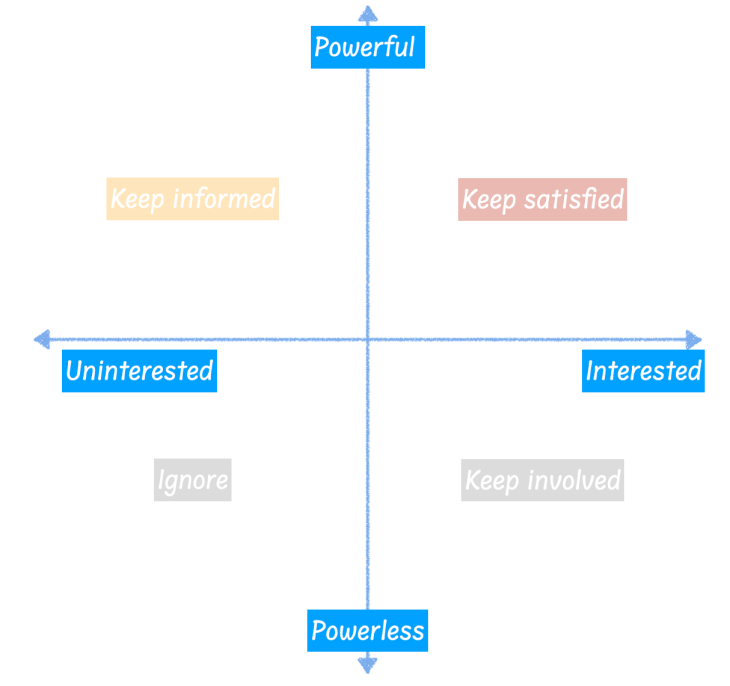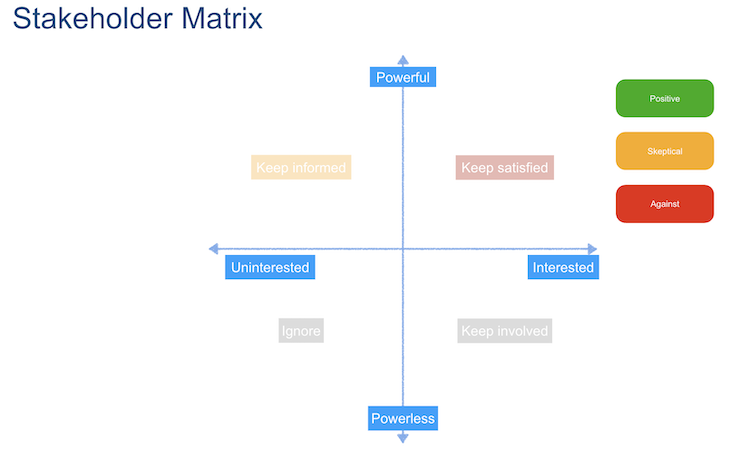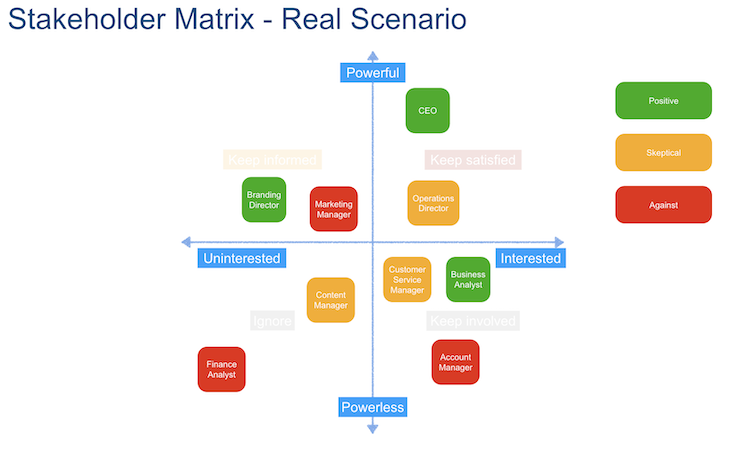People often ask me what makes or breaks product management. It’s a complex question, largely dependent on context, but one thing that consistently leads to failure is poor communication.

The sheer diversity of stakeholders you have to engage with is a challenge for any PM. It’s unlikely that you’ll have the capacity to fulfill all their requests, which means managing expectations and prioritizing effectively becomes crucial.
In one of my early roles as a product manager, I found myself overwhelmed trying to handle all the requests from various stakeholders, so I made the ill-advised decision to try and do a little bit of everything for everyone. In trying to please everyone, I ended up pleasing no one.
The situation became untenable, and it was clear that change was necessary. Otherwise, I would be forced to look for another job. This is where stakeholder mapping came into play.
Stakeholder mapping is a simple method for understanding your stakeholders’ landscape, including their level of power, interests, and attitude toward your product or initiative.
There are various ways to create a stakeholder map. You can design a high-level one that encompasses the entire product spectrum or opt for a more focused approach that zeroes in on current initiatives. Your specific context plays a significant role here.
A comprehensive stakeholder map provides an overview of your stakeholders and identifies areas where relationship-building may be needed. However, this might not address your immediate challenges. For instance, improving relations with an influential but skeptical stakeholder who isn’t involved in your current project won’t help you now — though it could benefit future initiatives.
On the other hand, creating a stakeholder map specifically for an important project or initiative can help you tackle pressing issues. This approach is more actionable and typically where I recommend starting.
In the long run, both types of stakeholder maps are beneficial but it’s worth considering what needs attention now versus later. Prioritization is key to making progress.
People and collaboration are crucial to product creation. However, the dynamics can be complex, and lumping everything together can lead to confusion.
Not all stakeholders are the same. For instance, while working in ecommerce, I was tasked with accelerating partner growth to increase offers in our shop. We decided to enable partners to self-board, but this introduced complexity.
The interests, influence, and attitudes of our stakeholders varied significantly. What an account manager wanted didn’t align with the needs of operations, while branding and category management had their own unique perspectives.
One might think that the easiest solution would be to gather everyone in a room and let them hash it out. But that approach would fall short of effective product management. A more thoughtful method involves creating a stakeholder map to understand the dynamics at play and then deciding on the next steps.
In 1991, Aubrey L. Mendelow developed stakeholder mapping as a tool to help teams determine how to interact with various stakeholder categories. Despite being over three decades old, this template remains relevant today.
Below is a modern stakeholder mapping template that I’ve adapted:

Powerful stakeholders have the ability to halt your initiative at any time or influence someone else who could do so. For instance, your company’s CEO is a powerful stakeholder, whereas a business analyst has less power.
Interest can be more nuanced. Some stakeholders may have a vested interest in your product or initiative for financial reasons. Perhaps their bonus depends on your product’s performance. Or, maybe your product directly impacts their work. For example, the marketing team will be highly interested in new features because they can use them to engage with audiences, advertise, and drive traction.
Let’s examine each quadrant:
While these quadrants provide a useful overview of your stakeholders and how best to collaborate with them, one element is missing: attitude. Some people will support you while others may oppose you — it’s important to identify these individuals and strategize how best to engage with them.
To visualize each internal stakeholder’s attitude, I use color coding:

Once you have a matrix like this one, you can start considering immediate actions based on it. In this example:
You can download a free template here.
Returning to my initial story, I felt I was on the brink of losing my job due to poor stakeholder management. To overcome this, I decided to map the stakeholders. But I couldn’t do it alone, so I enlisted the help of other product managers.
I chose to focus on the quarterly goals and map the related stakeholders. Together with two other product managers, we pragmatically positioned the stakeholders into the matrix, reflecting on their attitudes and adjusting accordingly.
The result is as follows (real names have been omitted):

As we crafted the mapping, it became clear that improving relationships was paramount. I couldn’t afford to have influential stakeholders working against us or interested stakeholders doing the same. So, I came up with the following actions:
After these one-on-one meetings, I understood that such stakeholders had been with the company for a long time and were tired of unfulfilled promises and repeated failures. For them, maintaining the status quo was preferable to investing their energy into something unproductive.
By categorizing the stakeholders, my life became easier. I knew where to direct my energy for fruitful results and who required less time in managing expectations or could even be ignored.
Now that we’ve explored what stakeholder mapping is and how it can be applied, let’s explore some best practices. These tips will help you get the most out of your stakeholder mapping efforts and ensure that your approach is effective and efficient:

LogRocket identifies friction points in the user experience so you can make informed decisions about product and design changes that must happen to hit your goals.
With LogRocket, you can understand the scope of the issues affecting your product and prioritize the changes that need to be made. LogRocket simplifies workflows by allowing Engineering, Product, UX, and Design teams to work from the same data as you, eliminating any confusion about what needs to be done.
Get your teams on the same page — try LogRocket today.

Promotions depend on proof. This guide shows PMs how to capture wins, feedback, and impact before review season.

Most teams fail at autonomy. Learn how clear rules help product teams move faster without micromanagement.

A practical framework for PMs to use AI in ideation without sacrificing judgment, strategy, or decision quality.

A practical five minute revenue estimation method to help product managers compare ideas, drop low impact features, and prioritize smarter.